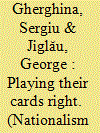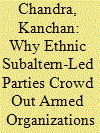| Srl | Item |
| 1 |
ID:
145471


|
|
|
|
|
| Summary/Abstract |
This article seeks to identify the determinants of ethnic parties’ access to coalition governments in Bulgaria, Romania, and Slovakia between 1990 and 2013. We conducted a cross-national and longitudinal analysis in which we took into account all the elections in which the ethnic parties gained parliamentary representation. With 21 cases over two decades—with the party at the election being the unit of analysis—and Qualitative Comparative Analysis (QCA) as the method of analysis, this study concludes that the pivotal position is important for access to government coalitions, while organizational change and government incumbency have a limited explanatory power.
|
|
|
|
|
|
|
|
|
|
|
|
|
|
|
|
| 2 |
ID:
165602


|
|
|
|
|
| Summary/Abstract |
This article asks why some Indian districts experience chronic Maoist violence while others do not. The answer helps to explain India’s Maoist civil war, which is the product of the accumulation of violence in a few districts, as well as to generate a new hypothesis about the causes of civil war more generally. The authors argue that, other things equal, the emergence of subaltern-led parties at the critical juncture before armed organizations enter crowds them out: the stronger the presence of subaltern-led political parties in a district at this juncture, the lower the likelihood of experiencing chronic armed violence subsequently. They develop their argument through field research and test its main prediction using an original, district-level data set on subaltern incorporation and Maoist violence in India between 1967 and 2008. The article contributes a new, party-based explanation to the literatures on both civil war and Maoist violence in India. It also introduces new district-level data on the Maoist movement and on the incorporation of subaltern ethnic groups by political parties in India.
|
|
|
|
|
|
|
|
|
|
|
|
|
|
|
|